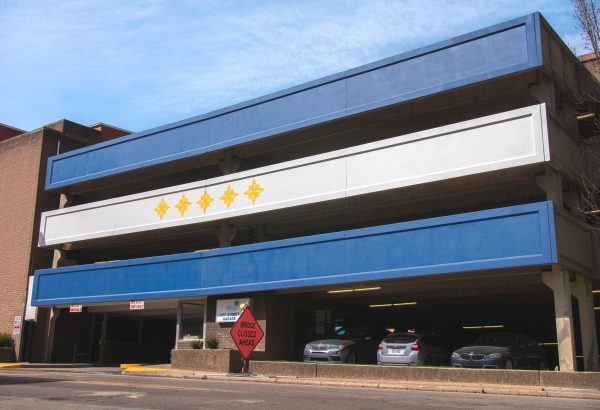Those of us who live in or have visited Wheeling know that it is an incredible city with plenty of character and history. Recently, Wheeling’s flag has been gaining quite a bit of attention for being one of the best city flags in the country. This is due in part to its unique design and receiving top marks in a survey conducted by North American Vexillological Association (NAVA).
The survey included 312 flags that participants rated on a scale of 0 to 10. Over 2,800 people completed the NAVA flag survey from Sept. 1 through Nov. 30. Wheeling’s flag was rated the #8 best flag, with a score of 7.52 out of 10. Wheeling was one of 46 flags included in the survey that received an “A” rating.
The City of Wheeling flag is an exciting symbol of our city’s unique history. It was adopted by City Council on September 5, 2018. The flag was designed by Erin Rothenbuehler, with input from Travis Henline and Jay Frey, and with history milestones developed by Sean Duffy to commemorate Wheeling’s 250th anniversary. The design was intended to recognize and honor our city’s rich past and build toward a brighter future our city.
Wheeling Flag Symbolism

The flag’s two horizontal blue bars at the top and bottom represent the Ohio River and Wheeling Creek, with a third white bar in the flag’s center. Together the three bars symbolize the three major modes of transportation that built Wheeling: river, road, and rail. In the white bar or field are five stars, each representing a major era in Wheeling’s historic past:
The Indigenous Star
This star represents Wheeling’s indigenous people including the Wyandot, Shawnee, Delaware (Lenape) and Mingo. “Wheeling” is derived from the place name “Wee-lunk” given by the Lenape, meaning “place of the skull.”
The Frontier Star
The star symbolizes the Zane brothers’ settlement of Wheeling in 1769. It also represents Fort Henry, which was besieged in 1777 and again in 1782. Wheeling’s most famous acts of pioneer heroism occurred in connection with the sieges. It was during the first siege that Major Samuel McColloch leapt on horseback down Wheeling Hill, escaping capture and death. During the second siege, Betty Zane made her dash from the fort to her brother’s block house, returning safely to the fort with gunpowder to resupply the defenders. The second siege is recognized as the last land battle of the Revolutionary War.
The Transportation Star
This star represents Wheeling’s significant role as a hub of early modes of transportation: the Ohio River, the National Road (1818) and the Baltimore and Ohio Railroad (1852).
The Statehood Star
The star symbolizes Wheeling’s importance in the Civil War as the birthplace of the only state born of that conflict and West Virginia’s first capital. It also honors the abolishment of slavery.
The Industrial Star
This star represents Wheeling as a manufacturing center producing iron, steel, cut nails, glass, tile, cigars and other goods. Wheeling’s industries attracted an influx of immigrants from Germany, Ireland, Poland, Italy, Lebanon, Greece, and Eastern Europe. Wheeling was in the vanguard of the labor movement and the formation of labor unions.
The Wheeling flag is an excellent example of a successful civic flag design. Its simple design is easily recognizable and the colors are meaningful to those of us who call Wheeling home. The fact that it was voted one of the best city flags in the NAVA survey is a testament to its quality and success and serves as a source of civic pride and a reminder of the city’s history and values.
If you would like to show off your Wheeling pride, you can purchase one of these flags at the Wheeling Artisan Center, located at 1400 Main Street in Downtown Wheeling.




